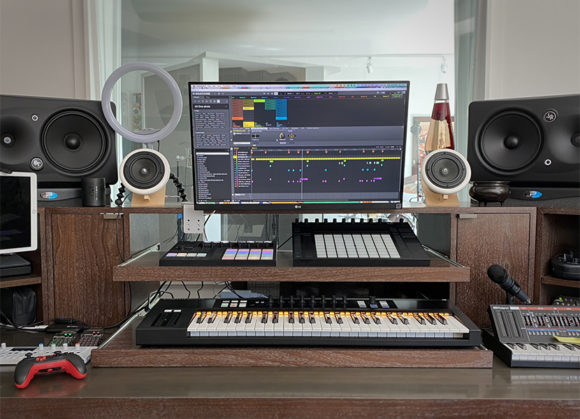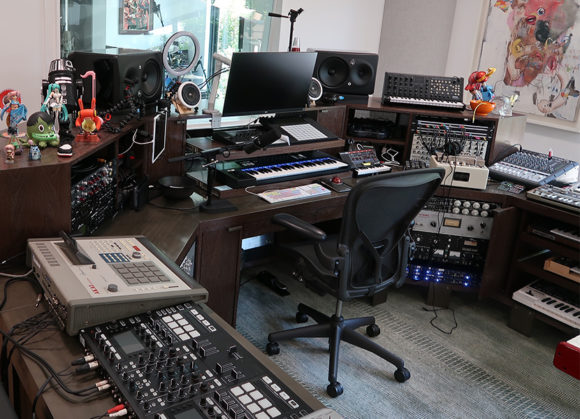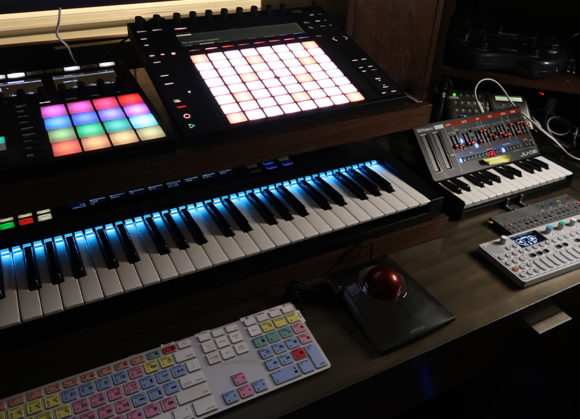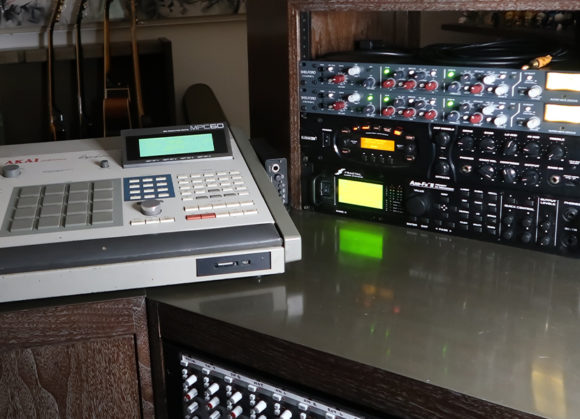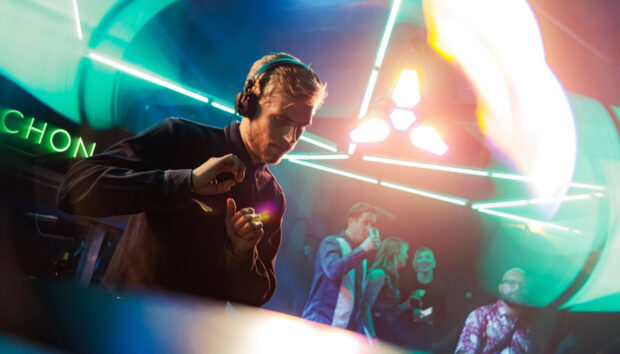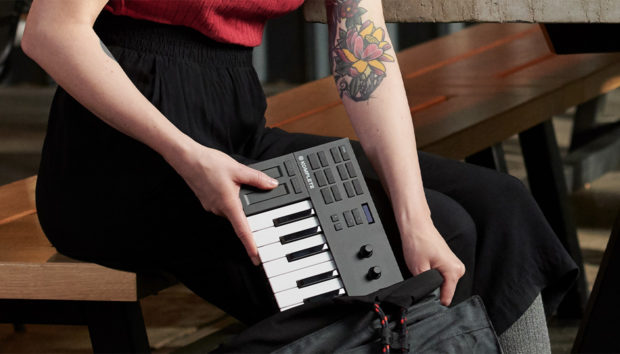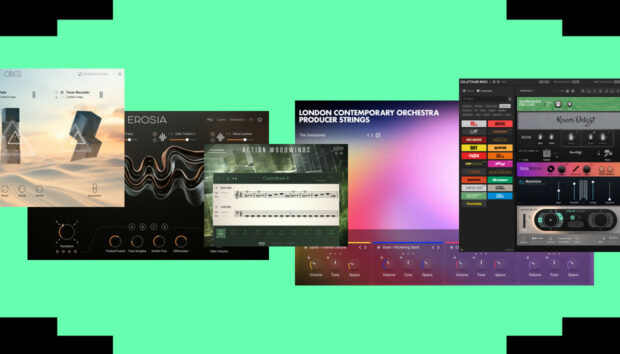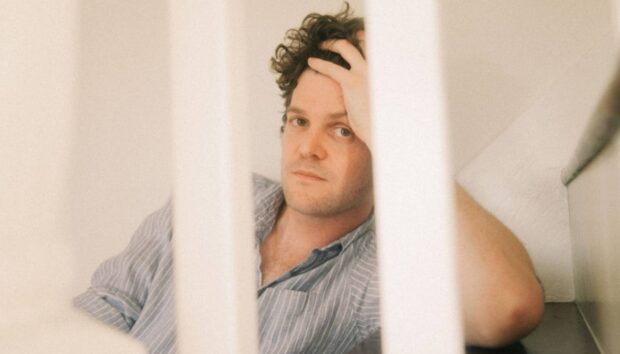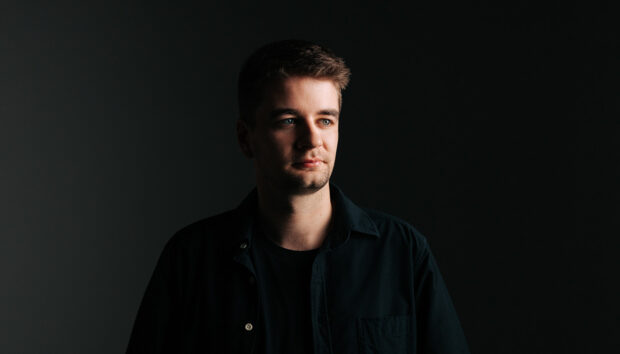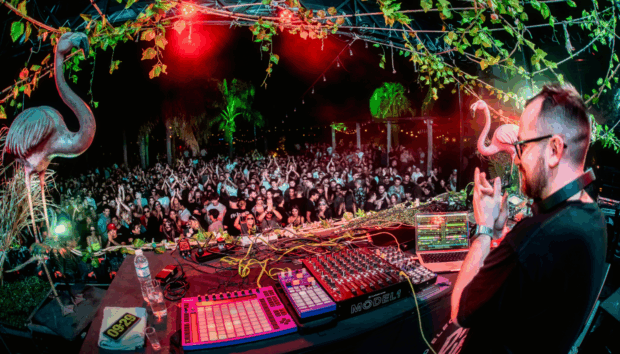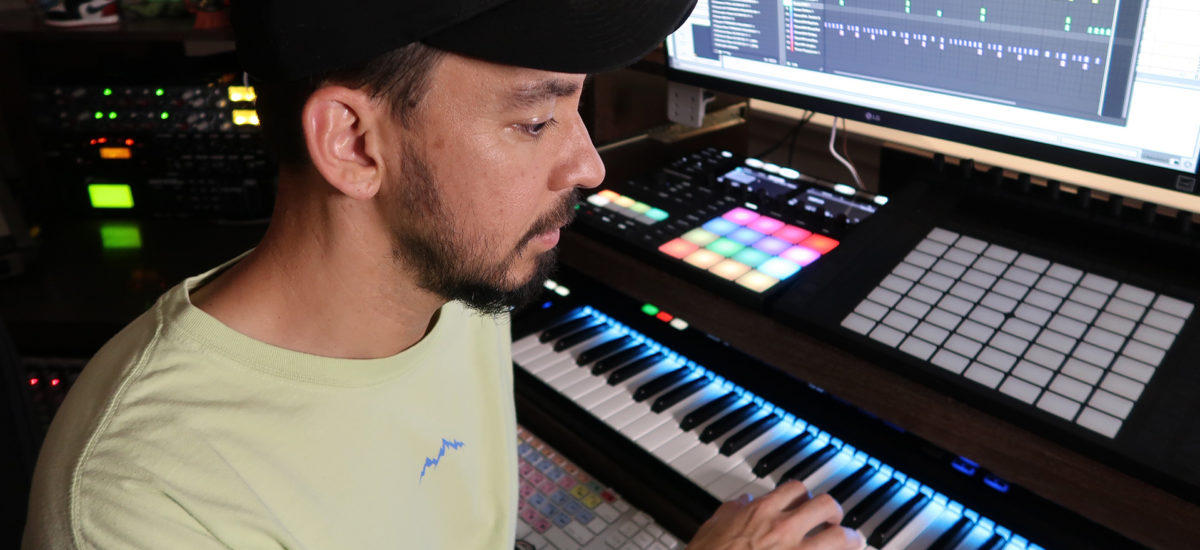
It’s 8:30AM in sunny Southern California and Mike Shinoda is already sitting at his home studio desk where, in a couple of hours time, he will go live to thousands of fans via Twitch. Since the COVID-19 quarantine started, Shinoda – the record producer, vocalist, and visual artist best known as co-founder of the band Linkin Park – has been posted up in this same spot nearly every weekday morning doing something interesting: making tracks with fans, demonstrating how sidechaining works, trying out new plug-ins, drawing dragons, and generally giving viewers a Truman Show-style window into whatever is going on in his head.
Shinoda offers viewers incentives to stay tuned to his stream – the more you watch, the more “Shinoda Bucks” you get, which you can use to ask production questions, select samples for Mike to use and submit genre suggestions for tracks, which Mike writes on little slips of paper and pulls out at random from a black bowl. On the stream, you can watch Mike mashing up horror movie music with mariachi hip-hop, trying his hand at melding Red Hot Chili Peppers funk with Prince funk and crafting songs in the style of K-Pop, Thriller-era Michael Jackson and the Pokémon Mew.
In just over four months, Shinoda and his fans have generated enough (mostly instrumental) music for three full albums – the first of which, the 12-track Dropped Frames Vol. 1, released on July 10. Dropped Frames, Vol. 2 was released on July 31st.
“I think two-thirds of the stuff I use on the stream is Native Instruments,” he explains. “The NI [user interface] is very familiar, so even if I pull up a new thing I can get into it in seconds. I also appreciate the quality and the aesthetic choices that get made in putting together a sample pack or whatever, and I just like the sounds. I’ve been using Maschine since the first one – right now, I’ve got the Mk3. I’ve got a Komplete Kontrol S49 keyboard because it fits in my desk perfectly. Even with my hardware stuff, I like having everything within arms reach. That’s part of the reason why I use Kontakt and Maschine so much because I feel like it’s the digital version of my analog set-up. I can get to the point where I’m taking what’s in my mind and making it real faster.”
Shinoda’s usual home setup involves a control room and a live room linked with a Hear Back OCTO monitoring set up, a full drum kit and several linked computers running ProTools HD, which makes it easy for him to self-record and engineer. For the Twitch stream, however, he’s opted for a more stripped back approach. “I decided to go with Ableton instead of ProTools because it kept the music going,” he explains. “You can do almost everything in Ableton while the song is still moving and playing: edit, add, subtract, record, delete. And I like the idea that when someone tunes in to my channel music is playing at all times. Even when I’ve got empty pads on my Maschine I’m trying to fill with sounds, I usually do it while the song is playing because then I can hear how the sound lives inside the track. My general rule is if I can do live drums I will, but on the streams I mostly use VSTs because of time and because Ableton can’t handle live drums. When I go out of the box, it’s for guitar or vintage keyboards; occasionally, a Roland MC-707 or an MPC 60 just for fun.”
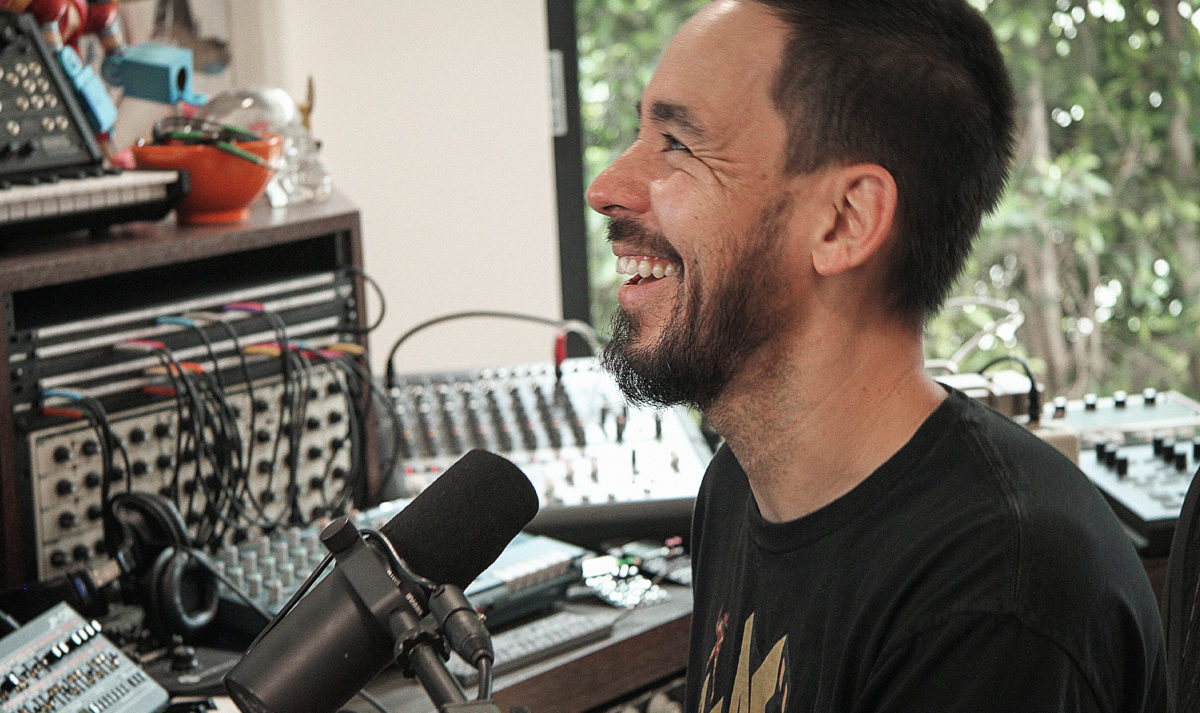
Mike’s Twitch streams are pretty seamless at this point, but the first month did involve a lot of experimentation: workflow tweaks, rewiring the studio to broadcast on Streamlabs’ OBS software and figuring out how to keep fans engaged. “I was finding out what things about writing a song are fun to me when other people are watching – where can I get a good result, have fun doing it and have it be fun to watch. When it comes to making tracks, I’m really confident doing it with other people in the room but when it comes to lyrics and vocals it’s harder for me to focus when other people are around. I realized that as long as I leave the vocal part out of it, I can make tracks with this chat room with people’s suggestions and it actually works really well.” Along the way, he’s worked out a daily quarantine schedule that allows him to be continuously creative. “I love the anchor that streaming weekday mornings at a given time has given me,” he says. “But I try not to overthink it too much. I kind of just go with what feels good and feels like it has built in momentum, and right now this feels really effortless.”
As you might guess, being able to find things quickly is paramount to making melodic metal or N*Sync-style 2000s pop on the fly. “I’ve collected samples and sounds for 25 years, so organization is really important. Knowing how to get the thing you want to get keeps your process fluid and fun. When it comes to organizing my folders in Maschine, lately I’ve been doing it by date. I find that keeping a good hierarchy – whether it’s by color or theme or whatever – is key. Taking a day here and there to just clean your closet and put your samples in a place where you’ll know where they are is so helpful. I also make little Post-It notes of stuff –patches I like or plug-ins I like that I forgot about, or stuff I always forget to use. That gives me something new I can go to when I’m in a rut or need a cool sound.”
After four months of streaming, Shinoda has tried out a variety of production workflows. “In the beginning, I left a lot of the sounds in Maschine and after a certain point I realized I needed to export more stuff out and put it on its own tracks in Ableton, just for control over sidechaining and stuff. On the songs on Dropped Frames Pt. 1 – which I mixed and mastered – I’m toggling in between mixing in Ableton and mixing inside Maschine. I treat Maschine almost like a bus and inside that group there’s sounds. If I’m going for a ‘live drum’ approach, I’ll usually pull things out into their own MIDI track or Instrument track in Ableton so I can see the notes or the hits on screen and jump in there easily and change the performance. But if I’m working on a drum-loop-type thing it will stay in Maschine. And I’m more apt to use the Maschine plug-ins – Transient Master or Supercharger Gt compressor or the RC 24 and 48 Reverbs – inside the Maschine than in Ableton for some reason.”
“I really push Maschine,” he continues. “I will have days in the studio where all I’ll do for the day is I’ll make sounds and sample sounds and put them in my Maschine library in new folders. I might borrow a friend’s keyboard and sample individual notes, then I’ll run the keyboard through guitar pedals and amps and sample that too. For midrange notes, I really like how it sounds to take a single note and expand it over the entire keyboard and change the attack and release and everything manually. Some of my favorite sounds are actually from a Prophet or a Juno, resampled into Maschine and used as a single note across the whole keyboard. I might play a polyphonic patch – like take a C and play two octaves higher or lower and it will sound entirely different.”
“I also prefer to make my own sounds. It gives me a gross feeling to use a stock patch. Even if I love the sound I started with I’ll tweak it just because… and sometimes I shouldn’t have done that,” he says, laughing. “I use a bunch of the different piano plug-ins in NI’s Kontakt because I play piano: Una Corda, Analog Dreams, Hybrid Keys. Lo-Fi Glow is awesome. I love the Symphony Series String Ensemble, and Retro Machines I use quite a bit too. And then I use some VSTs that are made by other people but they’re formatted for Kontakt: Damage, Decap Drums, Exhale.”
As you might expect from Shinoda’s often big-sounding and high-octane cuts, he’s a frequent Massive user as well. “I went through a heavy Massive phase – regular Massive, not Massive X,” he says. “I used it a lot on Living Things by Linkin Park and my solo record Post-Traumatic. There are a lot of really big nasty sounds in there that can act as a guitar and take up a lot of space. But I also used it for little arpeggios or swells in the background. I don’t have a set way of doing things – I’ll adapt to whatever the song seems like it wants to do or whatever the intention of the song is.”
“I’ll start with any type of sound, any type of groove, any type of idea,” he reveals. “I’ve whistled things into my phone, started a beat there, brought it into Maschine and then continued it. That actually became a Linkin Park song called ‘Lost in the Echo.’ That started with this kid’s cat keyboard that’s orange. I played a few chords on there that I love. Then I pulled out Maschine on my phone, sampled 16 different chord combinations, did some little patterns (but I didn’t love those), exported that onto my laptop and that’s when it took shape and became the intro and basically the backing structure of the song. I also used Maschine on a score for this smaller cult Indonesian action film called The Raid, which I worked on with Joe Trapanese. I put palettes of sounds together on Maschine, like multiple sessions of eight banks of 16 sounds. Each individual one might become the main sound for a scene. I feel like it became a really unique way to score. What was great about it is that I could adjust tempo, swing and key on the fly on my Maschine rig and then kind of sketch with it.”
When mashing up multiple styles, Shinoda pays close attention to what gives certain musical genres their unique vibe – the playing styles and instruments, how effects are used, the mixing techniques of the era and the overall sound palette – often studying tutorials and deep listening before Twitch sessions. Yet he doesn’t stick to any conventions when it comes to tempo. “I’m not a big subscriber to being in a certain BPM,” he offers. “Some people exist in that headspace and it’s very comfortable for them because they have something to start with and hang on to. I don’t care about that. I’ll get two hours into a session and decide it needs to be 5 BPM faster and just change it, even on records in ProTools with tons of audio. There’s always a moment of ‘Aw fuck! This is going to be a lot of work for the next day’ but it’s always worth it. If you’re making [dance] music for Ultra and Electric Daisy Carnival, then yes, you need to stick to certain tempos – that’s your job. That’s not my job. My job is to find the best groove, to find the best tempo and the best key, usually to serve the vocalist. If you’re making a song with vocals, always think, ‘What do I do to serve the vocalist?’ If it’s a rapper, are they rapping too fast or too slow? If I change the track a couple BPM will I be able to understand them better or will it be more or less exciting? Key with a singer is paramount. If you push the key down or up a couple steps, you’ll be able to tell the singer’s range and find their sweet spot. That’s another reason why I love working in this format with Maschine – it’s really easy to twist a knob and just change the key instantly.”
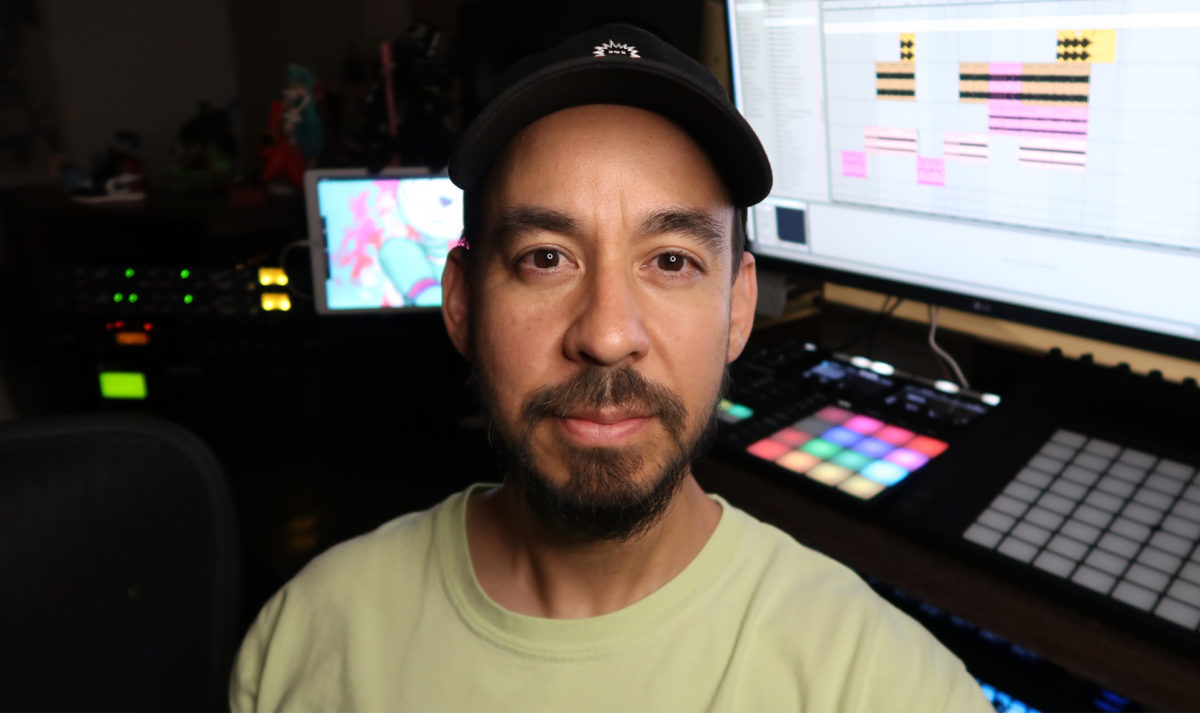
While Shinoda has definitely logged more than his 10,000 hours producing solo and with Linkin Park, streaming in front of a live audience with a chat room and the collaborative albums that come out of it have presented an exciting new set of things to learn. “It’s a big challenge,” he admits. “And I’m not going to hit the bull’s eye every day. At a certain point in some of these streams I’m like, ‘You guys, I can’t do Panic at the Disco. I don’t know enough about what that sounds like, or maybe I just can’t do it today and my track sucks. To me, it’s about constant dedication to the craft and constant learning. I would hate to be the kind of producer that has a recognizable sound and they have to make that sound every time. I write too often to be that guy. I would get sick of that in a week. I will make 100 things and none of them sound the same.”
Given how many hours Shinoda has spent inside the box, literally, he has some good advice for other artists looking to livestream. “Really look at your intention,” he says. “Why are you doing this? If your intention is more about taking from people than either being of value or giving, then you probably need to rethink it. Don’t take. Every social media software that we open is trying to take something from us! Can you make something, or open up a connection, that’s more two-way? Here are the things I get out of the streams: I get community, I learn things, I get to understand what people are thinking. We have people learning how to produce from the age of 14 to the mid-60s in the chat. I know that I’m giving people entertainment. I’m also definitely giving them information. The word ‘masterclass’ shows up every day. People will save up their Shinoda Bucks and put a music production question in, like ‘Go over sidechaining’ or ‘How much compression is too much?’ If I’ve got the answers to something like that, I’m happy to share it.”
Shinoda isn’t tired of streaming yet, but he’s leaving plenty of room for things to evolve. “I’m always on this weird aboriginal walkabout journey,” he offers. “It’s like a joke at this point. I just go from one thing to the next. I used to be really bad at overplanning and overthinking and now I try not to overthink it too much. If at some point the streams feel like they’re getting a little boring, let’s do something weirder and that becomes the next thing. Just go with flow. “
Make sure to follow Mike’s official Twitch channel for regular doses of production insight and inspiration. Dropped Frames Vol. 1 & 2 are available now on all major streaming services.








